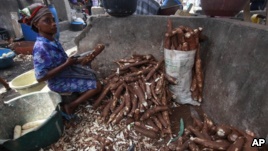VOA慢速英语:Diseases of Cassava Wreak Havoc in Africa
- 听力原文
- 参考译文
By VOA
21 October, 2013
From VOA Learning English, this is the Agriculture Report.
Cassava is an important crop in some countries. More than 160 million people across Africa depend on the plant for food or to earn money. The continent produces 60 percent of the world's cassava crop. The United Nations Food and Agriculture Organization reported last May that cassava production has increased by 60 percent worldwide since 2000.
Agricultural experts had been expecting it to grow even more during the next ten years as policy makers begin to understand the crop better, but those expectations have been crashed. The amount of cassava being grown in east and central Africa is falling because of diseases that reduce production.
Two such diseases of the cassava brown streak virus and cassava mosaic virus, they are wrecking Africa's agricultural lands. The UN's Food and Agriculture Organization says, brown streak disease does more damage since it affects the root of the crop.
 |
| A woman peels cassava to make cassava flour in a market in Lagos, Nigeria, May 2013. |
Luca Alinovi is the acting director of the FAO in eastern and central Africa. He says the agency has taken steps to improve the situation, but it is not getting better.
"Doing right or wrong on cassava has a huge impact on the food security of the people in this region, has such a relevance in our daily lives that we tend to forget it because it appeared in a kind of technical discussion. And I want to bring to your attention that, although it is a technical issue it requires knowledge and requires research."
Dominique Davoux heads the European Union Rural Development and Agricultural program in Kenya. He says the cassava diseases have changed over the years, he says there is need to invest in research to fight the diseases.
"We supported the cassava initially, there has been [a] stop in the support, the research slugged [lagged] behind, and the disease reinvented itself [and] propagated again. We have to re-address the issue."
The FAO says at least $100 million is needed. Some of the money would go to support clean farm production, collect information and study the diseases. The rest will go to market and micro-finance development across the cassava production chain.
Experts say failure to do so means the cassava disease will likely invade Nigeria, the biggest producer of cassava in Africa.
And that's the Agriculture Report from VOA Learning English. You can download transcripts and MP3s of all of our programs at our website, chinavoa.com. You can also find captioned videos at the VOA Learning English channel on YouTube. I'm Milagros Ardin.
From VOA Learning English, this is the Agriculture Report.
这里是美国之音慢速英语农业报道。
Cassava is an important crop in some countries. More than 160 million people across Africa depend on the plant for food or to earn money. The continent produces 60 percent of the world's cassava crop. The United Nations Food and Agriculture Organization reported last May that cassava production has increased by 60 percent worldwide since 2000.
木薯在一些国家是一种重要的农作物。非洲各地有超过1600万人以此为食或谋生。非洲大陆出产了全球60%的木薯。联合国粮食和农业组织去年5月报告称,自2000年以来木薯产量增长了60%。
Agricultural experts had been expecting it to grow even more during the next ten years as policy makers begin to understand the crop better, but those expectations have benn crashed. The amount of cassava being grown in east and central Africa is falling because of diseases that reduce production.
农业专家一直期待随着决策者更了解木薯,从而在未来十年种植更多。但这些期望都破灭了。因为一些会降低产量的疾病,非洲东部和中部的木薯种植面积锐减。
Two such diseases of the cassava brown streak virus and cassava mosaic virus, they are wrecking Africa's agricultural lands. The UN's Food and Agriculture Organization says, brown streak disease does more damage since it affects the root of the crop.
木薯褐色条纹病毒和木薯花叶病毒的两种疾病正在破坏非洲的农业用地。联合国粮食和农业组织表示,褐色条斑病造成的损害更大,因为它会影响作物的根系。
Luca Alinovi is the acting director of the FAO in eastern and central Africa. He says the agency has taken steps to improve the situation, but it is not getting better.
卢卡(Luca Alinovi)是粮农组织驻非洲中东部地区的代主任。他说,该机构已经采取了改善措施,但情况并未好转。
"Doing right or wrong on cassava has a huge impact on the food security of the people in this region, has such a relevance in our daily lives that we tend to forget it because it appeared in a kind of technical discussion. And I want to bring to your attention that, although it is a technical issue it requires knowledge and requires research."
他说,“木薯问题对该地区人民的粮食安全有着巨大影响,和我们的日常生活息息相关。我们往往忽视这点,因为它都出现在一些技术讨论中。我想提请大家注意的是,虽然这是一个技术问题,它也需要知识和研究。”
Dominique Davoux heads the European Union Rural Development and Agricultural program in Kenya. He says the cassava diseases have changed over the years, he says there is need to invest in research to fight the diseases.
多米尼克(Dominique Davoux)负责欧盟驻肯尼亚农村发展和农业项目。他表示,木薯疾病多年来已经有所改变,有必要在抗病研究上投资。
"We supported the cassava initially, there has been [a] stop in the support, the research slugged [lagged] behind, and the disease reinvented itself [and] propagated again. We have to re-address the issue."
他说,“我们一开始支持过木薯,中间一度暂停支持,在木薯上研究有点滞后,而且木薯疾病已经自我进化并再次传播。我们不得不重新解决这一问题。”
The FAO says at least $100 million is needed. Some of the money would go to support clean farm production, collect information and study the diseases. The rest will go to market and micro-finance development across the cassava production chain.
粮农组织表示,至少需要1亿美元。其中一些资金将用于支持农业清洁生产,收集信息和研究疾病。剩余资金将用于木薯生产链上的市场和微金融发展。
Experts say failure to do so means the cassava disease will likely invade Nigeria, the biggest producer of cassava in Africa.
专家表示,如果未能做到这些,就意味着木薯疾病可能会入侵尼日利亚这个非洲最大的木薯出产国。
- 频道推荐
- |
- 全站推荐
- 推荐下载
- 网站推荐




















